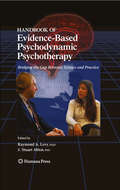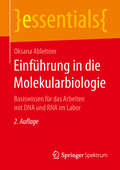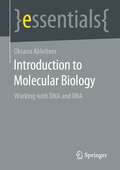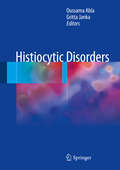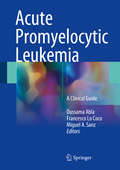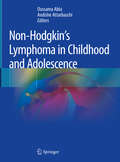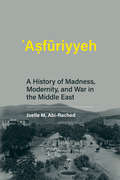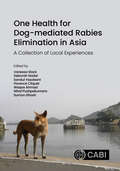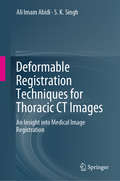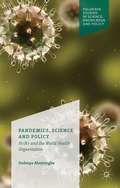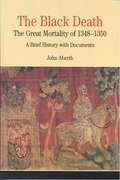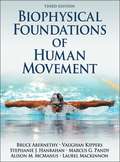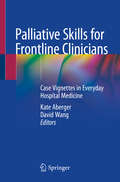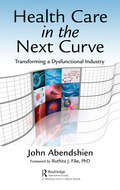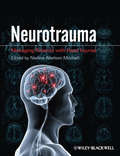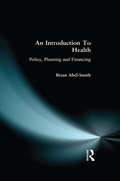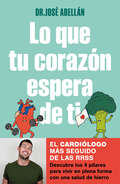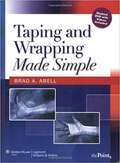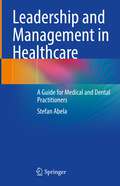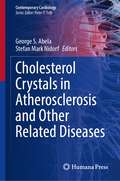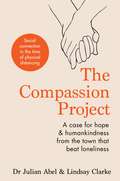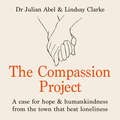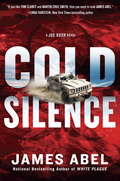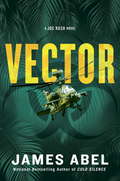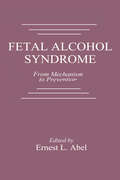- Table View
- List View
Handbook of Evidence-Based Psychodynamic Psychotherapy
by J. Stuart Ablon G. O. Gabbard Raymond A. LevyThe importance of conducting empirical research for the future of psychodynamics is presented in this excellent new volume. In Handbook of Evidence Based Psychodynamic Psychotherapy: Bridging the Gap Between Science and Practice, the editors provide evidence that supports this type of research for two primary reasons. The first reason concerns the current marginalization of psychodynamic work within the mental health field. Sound empirical research has the potential to affirm the important role that psychodynamic theory and treatment have in modern psychiatry and psychology. The second reason that research is crucial to the future of psychodynamic work concerns the role that systematic empirical investigations can have in developing and refining effective approaches to a variety of clinical problems. Empirical research functions as a check on subjectivity and theoretical alliances in on-going attempts to determine the approaches most helpful in working with patients clinically. Handbook of Evidence Based Psychodynamic Psychotherapy: Bridging the Gap Between Science and Practice brings together a panel of distinguished clinician-researchers who have been publishing their findings for decades. This important new book provides compelling evidence that psychodynamic psychotherapy is an effective treatment for many common psychological problems.
Einführung in die Molekularbiologie: Basiswissen für das Arbeiten mit DNA und RNA im Labor (essentials)
by Oksana AbleitnerOksana Ableitner bietet eine praxisnahe, klar strukturierte und gut verständliche Einführung in komplizierte Definitionen und Strukturen aus der Chemie und Molekularbiologie für die Arbeit im molekularbiologischen Labor. Die Autorin lässt sich dabei von ihrer Erfahrung im Umgang mit Studierenden leiten und nutzt viele Abbildungen, um abstraktes Wissen zu visualisieren. Das Verständnis für diese Materie ist eine essentielle Grundlage für erfolgreiches Arbeiten mit DNA und RNA, um ein qualitativ gutes Ergebnis zu sichern. Für die verantwortungsvollen Tätigkeiten in der Anwendung – wie bei der Genforschung oder Bestimmung diverser Krankheitserreger – ist es unerlässlich, sicher im Umgang mit den Grundlagen dieser sensitiven, schnellen und spezifischen Analysemethoden zu sein.
Introduction to Molecular Biology: Working with DNA and RNA (essentials)
by Oksana AbleitnerOksana Ableitner offers a practical, clearly structured and easy to understand introduction to complicated definitions and structures in chemistry and molecular biology for work in the molecular biology laboratory. The author is guided by her experience in working with students and uses many illustrations to visualize abstract knowledge. An understanding of this matter is an essential basis for successful work with DNA and RNA in order to ensure high quality results. For responsible activities in application - such as genetic research or the determination of various pathogens - it is essential to be confident in dealing with the basics of these sensitive, fast and specific analytical methods.This Springer essential is a translation of the original German 2nd edition essentials, Einführung in die Molekularbiologie by Oksana Ableitner, published by Springer Fachmedien Wiesbaden GmbH, part of Springer Nature in 2018. The translation was done with the help of artificial intelligence (machine translation by the serviceDeepL.com). A subsequent human revision was done primarily in terms of content, so that the book will read stylistically differently from a conventional translation. Springer Nature works continuously to further the development of tools for the production of books and on the related technologies to support the authors.
Histiocytic Disorders
by Oussama Abla Gritta JankaThis volume provides a comprehensive and world-class review of the field of histiocytic neoplasms and hemophagocytic lymphohistiocytosis (HLH). It reviews all the advances in the field of histiocytoses during the last ten years, particularly with regards to the genomic findings in LCH and other histiocytic neoplasms and the new suggested classification of the histiocytic disorders. Additionally, it features a state-of-the art update on the most recent treatment strategies for LCH, including the results of the last LCH-III international trial, salvage therapies such as reduced-intensity conditioning (RIC) stem cell transplant (SCT), and targeted therapies with BRAF and MEK inhibitors, as well as the challenging cases of CNS-neurodegenerative LCH and its therapeutic perspectives. For primary and secondary HLH the book updates the most recent genetic and pathophysiological findings, including macrophage-activation syndrome (MAS), and includes a special chapter on HLH in adults. Treatment chapters encompass therapy for newly diagnosed HLH and refractory disease as well as stem-cell transplantation and novel therapies. The text also highlights the most recent advances in the treatment of the uncommon histiocytic disorders, such as Erdheim-Chester disease (ECD), Juvenile xanthogranuloma (JXG) and JXG-like conditions, Rosai-Dorfman disease (RDD), and the very rare malignant histiocytoses. Written by international experts in the field, Histiocytic Disorders is a valuable resource for clinicians, researchers, fellows and residents who are interested in or manage histiocytic disorders in children and adults.
Acute Promyelocytic Leukemia: A Clinical Guide
by Oussama Abla Francesco Lo Coco Miguel A. SanzThis book provides a comprehensive overview on the clinical issues and biology of acute promyelocytic leukemia (APL) and on the molecular mechanisms of targeted therapy with ATRA and ATO. The text covers major topics such as the pathophysiology of APL coagulopathy, biologic and clinical differences between children and adults with APL, and the role of minimal residual disease monitoring. Additionally, the book summarizes historical, current, and future treatment strategies in both adults and children, while highlighting the most recent therapeutic recommendations for relapsed disease and the evolving indications for autologous and allogeneic stem cell transplant. This volume also features chapters focusing on secondary APL and therapy, late effects, rare presentations such as APL in the elderly and during pregnancy, and rare APL variants that may represent therapeutic challenges.
Non-Hodgkin's Lymphoma in Childhood and Adolescence
by Oussama Abla Andishe AttarbaschiThis text provides a state-of-the-art overview on Non-Hodgkin's lymphoma (NHL) in children and adolescents. The volume is divided into seven sections, each of which focuses on a critical component of pediatric NHL, including history and epidemiology, pathology and molecular biology, disease evaluation and response, common and rare sub-types of NHL, and current and novel treatment strategies. The text also comprehensively reviews the late effects of treatment, quality of patient life, and NHL treatment in countries with limited resources.Written by experts in the field, Non-Hodgkin's Lymphoma in Childhood and Adolescence is a valuable resource for clinicians and practitioners who treat children and adolescents with NHL.
Asfuriyyeh: A History of Madness, Modernity, and War in the Middle East (Culture and Psychiatry)
by Joelle M Abi-RachedThe development of psychiatry in the Middle East, viewed through the history of one of the first modern mental hospitals in the region.ʿAṣfūriyyeh (formally, the Lebanon Hospital for the Insane) was founded by a Swiss Quaker missionary in 1896, one of the first modern psychiatric hospitals in the Middle East. It closed its doors in 1982, a victim of Lebanon's brutal fifteen-year civil war. In this book, Joelle Abi-Rached uses the rise and fall of ʿAṣfūriyyeh as a lens through which to examine the development of modern psychiatric theory and practice in the region as well as the sociopolitical history of modern Lebanon.
One Health for Dog-mediated Rabies Elimination in Asia: A Collection of Local Experiences
by Ronello Abila Fiaz Ahmad Manzoor Ahmad Genki Arikawa Naila Baig-Ansari Suzanne Barber Omesh Kumar Bharti Victoria J. Brookes Eric Brum Karoon Chanachai Ashoka Dangolla Katinka De Balogh Timothy John Dizon Kinzang Dukpa Salome Dürr Anna S. Fahrion M. Aftab Gohar Ma. Ricci Gomez Gyanendra Gongal Mary Joy Gordoncillo Nicole Perreras Grande Silja Griss Mangala Gunatilake Katie Hampson Michael Hathaway Elly Hiby Akitoyo Hotta Satoshi Inoue Md Hamidul Islam Niti B. Jadeja S. Anzal Jaffari Wajiha Javed Ananda Jayasinghe Chandrika Jayasinghe Koji Kanda Chiho Kaneko Suwicha Kasemsuwan Pankaj Kc Rabia M. Khan Yumi Kirino Tipsarp Kittisiam Shintaro Kobayashi Hirofumi Kugita Kansuda Leelahapongsathon M. A. Masud Qamer Mahmood Daria Llenaresas Manalo Mary Elizabeth Miranda Noel Lee Miranda Naoaki Misawa Scott Newman Yooni Oh K.A.D.N. Perera Oswin Perera Wilaiwan Petsophonsakul Yoenten Phuentshok Ruwini M.S. Pimburage Supalak Prabsriphum Beatriz Puzon Quiambao Sreejith Radhakrishnan Onpawee Sagarasaeranee Naseem Salahuddin Luuk Schoonman David Sutherland Shynie Telmo Lesa Thompson Pasang Tshering Muhammad Rafi Ullah Abi Tamim Vanak Ad Vos Charlotte Warembourg Ewaldus Wera Tikiri Wijayathilaka Omala Wimalaratne Vilaiporn Wongphruksasoong Aya Yajima Takahiko Yoshida Kentaro Yoshii Mirava YusonAlthough an effective human rabies vaccine has existed since 1885, rabies continues to kill an estimated 59,000 people every year. Sixty per cent of these human deaths occur in Asia. The number of animals, especially dogs, who die of rabies is uncalculated. To work towards the global target of eliminating dog-mediated human rabies deaths, the rabies community is applying the One Health approach by jointly focusing on humans and dogs. Written by a multidisciplinary group of scholars and rabies control programme specialists, this book is a collection of experiences and observations on the challenges and successes along the path to rabies control and prevention in Asia. The book: -grounds chapters in solid scientific theory, but retains a direct, practice-focused and inspirational approach; -provides numerous examples of lessons learned and experience-based knowledge gained across countries at different levels of rabies elimination; -brings together and highlights the practices of a strong, international rabies network that works according to the One Health concept. Covering perspectives from almost a dozen Asian countries and a wide range of sectors and disciplines, such as healthcare facilities, veterinary services, laboratories, public health institutes, wildlife research centres and academia, this book is an invaluable resource for rabies practitioners and scholars, but also those working in the wider fields of disease control and cross-sectoral One Health.
Deformable Registration Techniques for Thoracic CT Images: An Insight into Medical Image Registration
by Ali Imam Abidi S.K. SinghThis book focuses on novel approaches for thoracic computed tomography (CT) image registration and determination of respiratory motion models in a range of patient scenarios. It discusses the use of image registration processes to remove the inconsistencies between medical images acquired using different devices. In the context of comparative research and medical analysis, these methods are of immense value in image registration procedures, not just for thoracic CT images, but for all types of medical images in multiple modalities, and also in establishing a mean respiration motion model. Combined with advanced techniques, the methods proposed have the potential to advance the field of computer vision and help improve existing methods. The book is a valuable resource for those in the scientific community involved in modeling respiratory motion for a large number of people.
Pandemics, Science and Policy
by Sudeepa AbeysinghePandemics, Science and Policy examines the case study of the World Health Organisation's (WHO) representation and management of the 2009 H1N1 Pandemic. It analyses key criticisms made about the WHO's actions through an examination of the social context in which pandemic management decisions were made, and ultimately illustrations the various ways in which the WHO's account was vulnerable to contestation. Abeysinghe provides a persuasive account of the interplay between uncertain science and the creation of global policy. The book demonstrates that the fragility of the WHO's account and decisions largely lay in both the (lack of) scientific evidence the WHO received, and its use and representation of this evidence. Importantly, it shows how uncertain risks can affect policy and action on the global level.
The Black Death: The Great Mortality Of 1348-1350 - A Brief History With Documents
by John AberthA fascinating account of the phenomenon known as the Black Death, this volume offers a wealth of documentary material focused on the initial outbreak of the plague that ravaged the world in the fourteenth century. A comprehensive introduction that provides important background on the origins and spread of the plague is followed by nearly 50 documents organized into topical sections that focus on the origin and spread of the illness; the responses of medical practitioners; the societal and economic impact; religious responses; the flagellant movement and attacks on Jews provoked by the plague; and the artistic response. Each chapter has an introduction that summarizes the issues explored in the documents; headnotes to the documents provide additional background material. The book contains documents from many countries -- including Muslim and Byzantine sources -- to give students a variety of perspectives on this devastating illness and its consequences. The volume also includes illustrations, a chronology of the Black Death, questions to consider, a selected bibliography, and an index.
Biophysical Foundations of Human Movement (3rd Edition)
by Bruce Abernethy Vaughan Kippers Stephanie Hanrahan Marcus Pandy Ali Mcmanus Laurel Mackinnon"Biophysical Foundations of Human Movement, Third Edition," introduces readers to key concepts concerning the anatomical, mechanical, physiological, neural, and psychological bases of human movement. The text provides undergraduate students with a broad foundation for more detailed study of the subdisciplines of human movement and for cross-disciplinary studies. Readers will learn the multi-dimensional changes in movement and movement potential that occur throughout the life span as well as those changes that occur as adaptations to training, practice, and other lifestyle factors. This third edition includes the latest research and improved presentation to address areas of growth and change in the fields of human movement. The following are important updates to this edition: - A new chapter on historical origins of human movement science provides students with an appreciation of the development of the field as well as its future directions. - Content regarding exercise physiology has been reorganized to provide more discrete coverage of key concepts in nutrition. - A new concluding section focuses on applications in the areas of prevention and management of chronic disease, prevention and management of injury, and performance enhancement in sport and the workplace, as well as the benefits of sport and exercise science to work, sport, and everyday living. - Ancillary materials support instructors in teaching across disciplines as they assist students in understanding the breadth of content in this comprehensive text. Using a modular approach to teaching sport and exercise science, "Biophysical Foundations of Human Movement, Third Edition," offers students a structured understanding of how the subdisciplines work independently and in tandem. Following a general introduction to the field of human movement studies, readers are introduced to basic concepts, life-span changes, and adaptations arising in response to training in each of the five major biophysical subdisciplines of human movement. Each subdiscipline is given a brief introduction, including the definition and historical development of the subdiscipline, the typical issues and problems it addresses, the levels of analysis it uses, and relevant professional training and organizations. Multi-disciplinary and cross-disciplinary approaches to human movement are also discussed along with contemporary applications. By studying the integration of knowledge from a number of the biophysical subdisciplines, students will be better prepared for advanced study and careers reliant on the integration of knowledge from various disciplines and perspectives. The third edition offers tools for retaining the material, including learning objectives and summaries in each chapter, a glossary, and lists of web-based resources. Throughout the text, special "In Focus" features highlight key organizations, individuals, and studies from around the world that have contributed to the current understanding of human movement. These features help readers appreciate the evolution of the field so that they may better understand its direction. Students interested in further study will find specialized texts for each of the subdisciplines listed in the Further Reading and References section of each chapter along with updated lists of websites. The third edition of "Biophysical Foundations of Human Movement" offers a comprehensive introduction for students, scientists, and practitioners involved in the many professions grounded in or related to human movement, kinesiology, and sport and exercise science. By considering the effect of adaptations in each of the biophysical subdisciplines of human movement, "Biophysical Foundations of Human Movement" also illustrates the important role physical activity plays in the maintenance of health throughout the life span.
Palliative Skills for Frontline Clinicians: Case Vignettes in Everyday Hospital Medicine
by Kate Aberger David WangRooted in everyday hospital medicine, Palliative Skills for Frontline Clinicians addresses the challenges of delivering complex care to patients living with serious illnesses. Spanning emergency medicine, internal medicine, surgery and various subspecialties, each chapter reads like a story, comparing usual care with a step-by-step palliative-based approach. This case-based book features a multidisciplinary, palliative-trained authorship, including neurologists, nephrologists, emergency physicians, surgeons, intensivists, and obstetricians. Divided into four parts, Palliative Skills for Frontline Clinicians outlines common clinical scenarios across settings and specialties to highlight unmet needs of patients with potentially terminal illnesses. Each case is broken down into the usual standard approach, and delves into detail regarding different palliative interventions that can be appropriate in those scenarios. These are meant to be practice changing; down to the actual words used to communicate with patients. In addition to the book’s focus on the principles of palliative care and the “art” of treating the patient, approaches to communication with the patient’s families for the best long-term outcomes are discussed. Concise and pragmatic, Palliative Skills for Frontline Clinicians is meant to be practice changing. It provides readers with both a new conceptual framework, as well as actual words to communicate with patients and medication doses for symptom management. It is an invaluable resource for non-palliative trained clinicians who wish to strengthen their palliative care skills.
Health Care in the Next Curve: Transforming a Dysfunctional Industry
by John AbendshienHealthcare in the U.S. is a critical juncture. We face a sharp upward rise in the number of people with chronic diseases and disabilities. As demands on our current health system grow, so will costs. But as a society we are approaching the upper limit of how much we are willing (or able) to spend on health care. Health care policy makers know this. That is why major health reform measures are focused on population health and value-based care. These are the so-called second curve objectives. But these initiatives are doomed to failure. We are asking a system to do things that it was not designed to do. In fact, we don’t have a health care "system" as such. We have a parts bin of disconnected silos. Fragmented delivery systems. Specialized caregivers. Professional groups. Trade associations. All with distinct cultures. Each with their own motivations and agendas. Our payer and regulatory structures have evolved over the decades in response to political and policy initiatives. However well intentioned (or not), these structures defy logic. They reward and reinforce counter-productive industry behaviors. They pose formidable roadblocks to achieving needed changes. Current reform initiatives are an implicit recognition that our health model is flawed. The attitude seems to be, "Yes, we know the overall health system is a problem, but we can make failure less severe if we implement these measures." We are at a critical juncture. We can continue to place additional demands on an industry model that has outlived its functional utility. Or we can take more of a clean slate approach and move toward a model that is in keeping with today’s needs. The outlook is not good if we stay on the current curve. The demands on resources will continue their upward trajectory. The default scenario will be one of rationing and less to invest in new cures and new technologies. The good news is that we are within sight of a future state of health care that can really work. In this future state, we have gotten rid of the artificial barriers to effective and efficient patient care. Physicians and other health professionals work in a coordinated, inter-disciplinary fashion. They have accountability for the whole care cycle. Caregivers have both the flexibility and encouragement to innovate and come up with optimal delivery approaches. And because they are in a risk-reward relationship with payers, they have the incentives to provide true value. Patients feel intimately connected to a system that is focused on their specific needs. The key to this future state is good old-fashioned market discipline. Other delivery models must either improve or get out of the way. The market will demand cost-efficiencies and won’t tolerate waste. Much of our regulatory structure will be rendered unnecessary. There will be not rewards for poor performance. This book takes a unique macro-level perspective of clinical, economic, and regulatory problems and possible solutions. It takes an objective and something scathing look at current industry structure: a silo-driven culture and entrenchment that is driven by self-interest; as well as the complicity of government in preserving the status quo through regulations, licensure, payment systems, etc.
Neurotrauma
by Nadine Abelson-MitchellNeurotrauma: Managing Patients with Head Injuries is a comprehensive, holistic, evidence-based approach to the primary, secondary and tertiary care of a person with neurotrauma.Using a patient-centred needs approach to enhance the quality of care of head injured patients, family and carers, this multidisciplinary book enables the reader to apply the knowledge, skills and attitudes learned to the practice of neurotrauma in all settings. It explores:Anatomy and physiology of the brainPharmacology for neurotrauma patientsAssessment of the patient with neurotraumaManagement of neurotrauma in a range of settings including at the scene, in the emergency department, and at the hospitalNeuro-rehabilitationCommunity careNursing management of the patientThis practical resource includes activities, exercises, and ethical and legal considerations throughout, making it ideal reading for all staff working in neuroscience, emergency, critical and rehabilitation settings.
An Introduction To Health: Policy, Planning and Financing
by Brian Abel-SmithThis book concerns itself with the key question: how to improve health in a cost effective and politically acceptable way. What makes people healthy? Why are the poor less healthy than the rich? Why do some countries have a better health record than others? An Introduction to Health is divided into four parts comprising the determinants of health, health service planning, health service financing, and controlling costs and securing user-friendly services.
Lo que tu corazón espera de ti: Descubre los 4 pilares para vivir en plena forma con una salud de hierro
by Dr. José AbellánUn enfoque integrativo de la salud, con el corazón en el centro, para prevenir las enfermedades y mejorar nuestra calidad de vida. El principal motivo por el que enfermamos en la actualidad es que nuestro estilo de vida contradice lo que el cuerpo y el corazón esperan de nosotros: pasamos largas horas sentados, comemos alimentos procesados, sufrimos estrés, ansiedad, insomnio..., vivimos desconectados de nuestra naturaleza y de nuestro entorno. Esta es la raíz de muchas enfermedades, en especial las cardiovasculares, que, según la OMS, están detrás de una de cada tres muertes en el mundo y representan la mayor amenaza para nuestra salud. Y los números no paran de empeorar. En este libro, el cardiólogo José Abellán explica de manera clara y directa la importancia de cuidar la salud de nuestro corazón para evitar enfermedades y tener una vida sana, larga y activa. Con un enfoque centrado en la prevención y la incorporación de hábitos saludables, el autor profundiza en los cuatro pilares de la salud cardiovascular: * No comas, aliméntate* Muévete* Sincronízate con los ritmos del planeta y descansa* Conecta con los demás y con la naturaleza Con Lo que tu corazón espera de ti entenderás, por fin, qué necesita tu cuerpo para estar sano y aprenderás a adecuar tu estilo de vida para gozar de una salud óptima.Toma el control de la situación. Si aprendes a prevenir, no tendrán que curarte. Los expertos opinan:«José ha escrito un libro maravilloso. Lo que tu corazón espera de ti encierra mucho: por qué se produce la enfermedad y, a partir de ahí, cómo debemos alimentarnos, cómo debemos entrenar, cómo debemos sincronizarnos con el planeta y cómo debemos cuidarnos a nosotros y cuidar a los demás. Sácale jugo, aprende y disfrútalo». JORDI CRUZ, chef seis estrellas Michelin «El doctor Abellán defiende la alimentación y su poder antiinflamatorio como base para la prevención de enfermedades; en su libro desmiente de forma sencilla los principales mitos de la alimentación y su efecto en la salud cardiovascular».BLANCA GARCÍA-OREA, nutricionista, autora de Dime qué comes y te diré qué bacterias tienes «El doctor Abellán consigue transmitir los fundamentos que explican por qué el ejercicio físico y la alimentación son vitales para la salud de tu corazón. Además, explica otros factores relevantes en la salud cardiovascular, como, por ejemplo, la conexión social o el estrés. Un libro asequible y claro para mejorar tu salud plena».ISMAEL GALANCHO, nutricionista, autor de Quema tu dieta«En este libro, el doctor Abellán transmite, con un lenguaje muy sencillo y directo, lo importante que es para el corazón sincronizar tus relojes internos con los ciclos del planeta. Con su lectura aprenderás que la salud se trabaja y se gana día a día, y entenderás por qué descansar adecuadamente es uno de los pilares de una vida sana».JUAN ANTONIO MADRID, investigador experto en cronobiología, autor de Cronobiología. Una guía para descubrir tu reloj biológico «En esta época de confrontación, el doctor Abellán muestra de manera muy clara la importancia de cuidarnos, mimar nuestras relaciones con los demás y huir del estrés crónico para gozar de buena salud. Lo que tu corazón espera de ti es, en cierto modo, una delicada manera de tomar consciencia».Coronel PEDRO BAÑOS, especialista en geoestrategia y defensa, autor de Así se domina el mundo
Taping and Wrapping Made Simple
by Brad A. AbellTaping and Wrapping Made Simple is a basic yet comprehensive guide to taping and wrapping. Designed with the beginner or novice in mind, this text introduces the reader to basic anatomy, medical terminology, and general taping techniques. <p><p> The book begins by introducing essential supplies and terminology and then moves on to the basic foundation in taping and wrapping techniques as well as injury and wound care. The remainder of the book presents simple-to-follow procedures for the lower and upper body.
Leadership and Management in Healthcare: A Guide for Medical and Dental Practitioners
by Stefan AbelaThis book is a comprehensive guide to leadership in healthcare and the management of complex clinical scenarios in the medical or dental practice. Training in leadership and hospital management is not part of the curriculum and so guidance is often not provided in depth.This book outlines strategies for dealing with the management problems that arise in the healthcare profession, and it prepares the reader for interviews, examinations and the supervision of a team. It opens with an overview of the NHS, its evidence-based practice and healthcare regulations. Subsequent chapters discuss data protection, management of new business cases, formal complaints and inappropriate use of social media. Information is provided on the recruitment of new junior trainees, the management of underperforming allied health professionals, and the handling of injuries sustained at work. This book is ideal for final-year medical and dental undergraduate students, foundation year doctors, core trainees, junior and senior specialists and newly-appointed consultants.
Cholesterol Crystals in Atherosclerosis and Other Related Diseases (Contemporary Cardiology)
by George S. Abela Stefan Mark NidorfThis book is the first authoritative and comprehensive text dedicated to the understanding of how cholesterol triggers vascular inflammation and mechanical injury that leads to heart attacks, strokes as well as other organ and tissue pathology. It includes chapters on the background of cholesterol crystal formation and methods for their detection as well as a description of the physiochemical transformation of metastable ‘liquid’ cholesterol to a solid flat plate crystalloid within the cellular and extracellular environment resulting in volume expansion. Chapters also discusses cholesterol crystals and other crystalloid molecules found in atherosclerotic plaque. In addition, the book examines how cholesterol crystals can induce similar injurious processes in other organs including the retina of the eye to cause blindness, in solid cancers causing further tumor growth and in the brain of patients with Alzheimer’s. And lastly, the book addresses various potential therapeutics that disrupt the physiochemical transformation of cholesterol from a liquid to a solid, inhibit its role in triggering inflammation and tissue injury while ushering a path towards targeted therapies.Cholesterol Crystals in Atherosclerosis and Other Related Diseases will be of interest to cardiologists as well as individuals in various fields of science including crystallography, basic and clinical imaging, cardiac oncology, and drug discovery.
The Compassion Project: A case for hope and humankindness from the town that beat loneliness
by Julian Abel Lindsay Clarke'A wonderful book' - Dr. Rangan Chatterjee'Highly convincing' - Daily Express'Pioneering' -The Telegraph'The strength of the book lies in its description of how community life can have a transformative effect on individuals' - British Journal of General PracticeAcross the country, general hospital admissions are on the rise. But in a small town in rural England, thanks to the simple introduction of kindness and compassion, that trend has been reversed. And what this town achieved, we can all adopt in our own lives to powerful effect. Through daily mindful acts of care we are capable of changing things for the better, both inside ourselves and for the world around us. Frome in Somerset isn't special. It could be any town; it could be your town. And yet the people who live there have a story to tell about the simple, ground-shaking power of compassion. If it came in tablet form, it would be hailed as a wonder of modern medicine. By contrast, it's entirely free but offers heartening evidence that when human beings make time for each other, the beneficial effects go far beyond the reach of naïve optimism.'A culture in which compassion is a prevailing value allows individuals to flourish and bring their talents and gifts to the communities in which they live. Unanticipated possibilities emerge, presenting fresh ways of addressing what previously appeared to be insoluble problems. Hearts are lifted. The case for hope is more strongly made. And as the people who work in this way begin to change the world immediately around them, so too, the wider world beyond begins to change.' Dr Julian Abel & Lindsay Clarke
The Compassion Project: A case for hope and humankindness from the town that beat loneliness
by Julian Abel Lindsay Clarke'It could... be one of the most dramatic medical breakthroughs of recent decades. It could transform treatment regimes, save lives, and save health services a fortune. Is it a drug? A device? A surgical procedure? No, it's a newfangled intervention called community.' George Monbiot, The GuardianFrome in Somerset has seen a dramatic fall in emergency hospital admissions since it began a collective project to combat isolation. While emergency admissions to hospitals across Somerset have increased by 29%, incurring a 21% increase in costs, Frome has seen admissions fall by 17%, with a 21% reduction in costs.Society has developed in such a way to facilitate a drastic malnourishment of community, connection and compassion. This book sets out the case for the effective restoration of the active power of compassion as a widely available, fundamental force for good in all aspects of human life. In the process, it draws attention to research which demonstrates that an innate capacity and need for compassionate behaviour is closely woven into the fabric of our bodies.But this is also a book with stories to tell - the stories of how, by harnessing the power of compassion in the lives of real men and women, the small English town of Frome has opened up a new approach to the practice of medicine which has improved individual health and welfare while at the same time enhancing the vitality of the whole community. The effects of this approach have proved so beneficial that it has attracted international attention and is now transforming perspectives on issues of healthcare and social welfare across the world.(p) 2020 Octopus Publishing Group
Cold Silence (Joe Rush #3)
by James AbelJames Abel--author of the electrifying Joe Rush novels Protocol Zero and White Plague--unleashes another heartstopping thriller in which an unholy plague from the past has been awakened...While trying to alleviate the suffering of thousands in drought-stricken, war-torn Africa, ex-Marine doctor and bio-terror expert Joe Rush receives a plea for help from a member of his old military unit, currently working as a geologist in a chaotic region of Somalia.Joe arrives on the scene to find an entire group showing horrific symptoms of an ancient sickness once thought to be sent as punishment from heaven. But before Joe can get hard evidence identifying the illness, a local warlord takes matters into his own hands--and the proof is gone just as the illness breaks out back in the United States.This outbreak is not a curse from God. It's a well-coordinated, meticulously planned attack with a specific goal that could overturn global stability and kill millions. And the only one who can stop the downfall of civilization is Joe Rush...From the Hardcover edition.
Vector
by James AbelJoe Rush takes on a new terror, spawned in the Amazon rain forest, that threatens to bring the world to its knees in James Abel's latest bio-thriller, now in paperback.While studying new forms of malaria at an Amazon gold rush, Joe Rush's best friend and partner, Eddie Nakamura, disappears. Learning that many of the sick miners have also vanished, Rush begins a search for Eddie that takes him into the heart of darkness--where while battling for his life, he discovers a secret that may change the world. Thousands of miles away, sick people are starting to flood into U.S. hospitals. When the White House admits that it has received terrorist threats, cities across the Northeast begin to shut down. Rush and his team must journey from one of the most remote spots on Earth to one of the busiest, as the clock ticks toward a kind of annihilation not thought possible. They have even less time than they think to solve the mystery, for the danger--as bad as it is--is about to get even worse.
Fetal Alcohol Syndrome: From Mechanism to Prevention
by Ernest L. AbelRecognition of the relationship between alcohol abuse and adverse prenatal outcomes is reflected in the warning labels on every alcoholic beverage sold in the United States. Because alcohol abuse has serious consequences for both individuals and society as a whole, much research has been devoted to this problem. Fetal Alcohol Syndrome provides straightforward facts regarding the impact of alcohol consumption as it affects the development of the embryo and fetus. Surveying current research of fetal alcohol syndrome and its related problems, the book addresses the immediate effects on development at various stages. Long-term action of prenatal alcohol exposure later in life is also considered. A chapter devoted to assessing the behavior of children who were prenatally exposed to alcohol emphasizes the necessity of longitudinal studies of fetal alcohol syndrome. This important reference offers a thorough overview of a problem that cannot be ignored.
